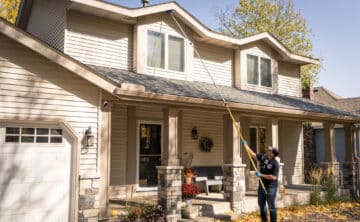What to Do About Wasps in Minnesota
It’s hard to keep your cool when yellow jackets or wasps target your summer picnic. Because they are more aggressive than bees, these stinging visitors can make everyone anxious, and they’re hard to ignore. If you have children, pets, or people who are allergic, avoiding stings is especially important. Additionally, you should always treat for wasps if you see them flying in and out of a small hole in the side of your home.
Stay safe from stinging insects at home and outdoors
First, understanding if you are dealing with a bee, wasp, yellowjacket, hornet, or other stinging insect found in the Twin Cities area is important. Bees are generally round with fat, furry bodies. Wasps and yellow jackets are longer and thinner with shiny bodies that have little or no visible fur.
- Bees will generally not bother you unless threatened. If you think bees are nesting in a sensitive location where they might encounter people, such as near a doorway, contact a beekeeping expert to help relocate the colony. Additionally, beehives, or nests, are made out of wax, not paper.
- Wasps and yellowjackets can be difficult to manage on your own because they can be aggressive, especially when defending a hive or nest. Over the counter wasp sprays and repellants are contact kill insecticides and provide no protection once dry.
Read more on how to determine which type of stinging insect you have!

Wasp and yellowjacket prevention tips
Preventing stinging insect nests on your Minnesota home
- Look for signs of a nest, especially along the south or southwest facing side of your home.
- Inspect under gutters, overhangs, and peaks. The backsides of shutters and second story decks are also common nesting areas.
- Take action in spring to prevent wasps nesting on your home—wasps nest in May and June.
- Treat or remove nests before they are well established—even a small nest can have hundreds or thousands of wasps.
- Never seal up a wasp opening before eliminating the hive, or you risk driving them further into your home. Wasps have chewing mouthparts just like carpenter ants and can chew through sheetrock and wood.
Tips to avoid wasp and yellow jacket stings
- Wasps are typically less active in early morning or late evening.
- Wear protective clothing, especially if you are outside in mid-day or near active nests.
- Serve food and drinks just before eating to avoid attracting yellowjackets, and look before you sip when eating outdoors!
- Keep garbage cans tightly covered and store them away from people.
- Over the counter products only kill on contact; they will not target the nest.
- Consider professional treatment for your home—commercial products leave a protective residual up to 60 days after being applied.
Have a stinging insect problem in the Minneapolis and St. Paul area? Our experts can help you get rid of them!
Other items you may be interested in:

One-time Services
We offer single-service pest control for the homeowner with a single pest problem–no contract required!

Is It A Bee, Wasp, Yellowjacket, Or Hornet?
Minnesota is home to several stinging insects, and the most commonly found ones are bees, wasps, yellowjackets, and hornets. While all can sting, they vary

Wasp & Hornet Control
Whether you’re looking for prevention or treatment of existing nests, we can help keep you from getting stung!



